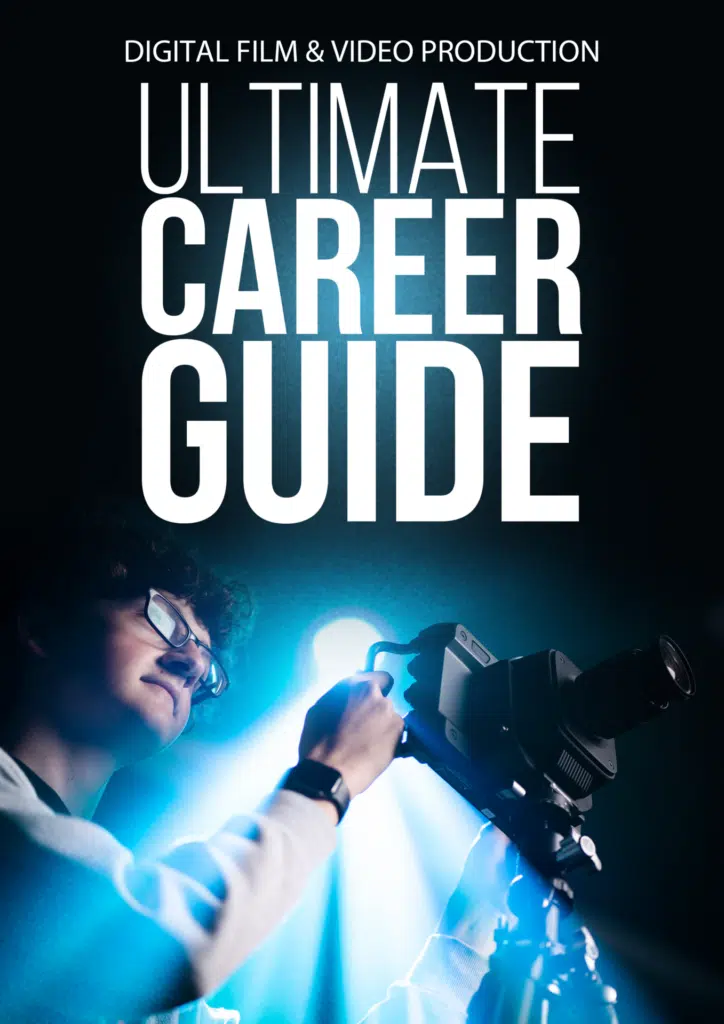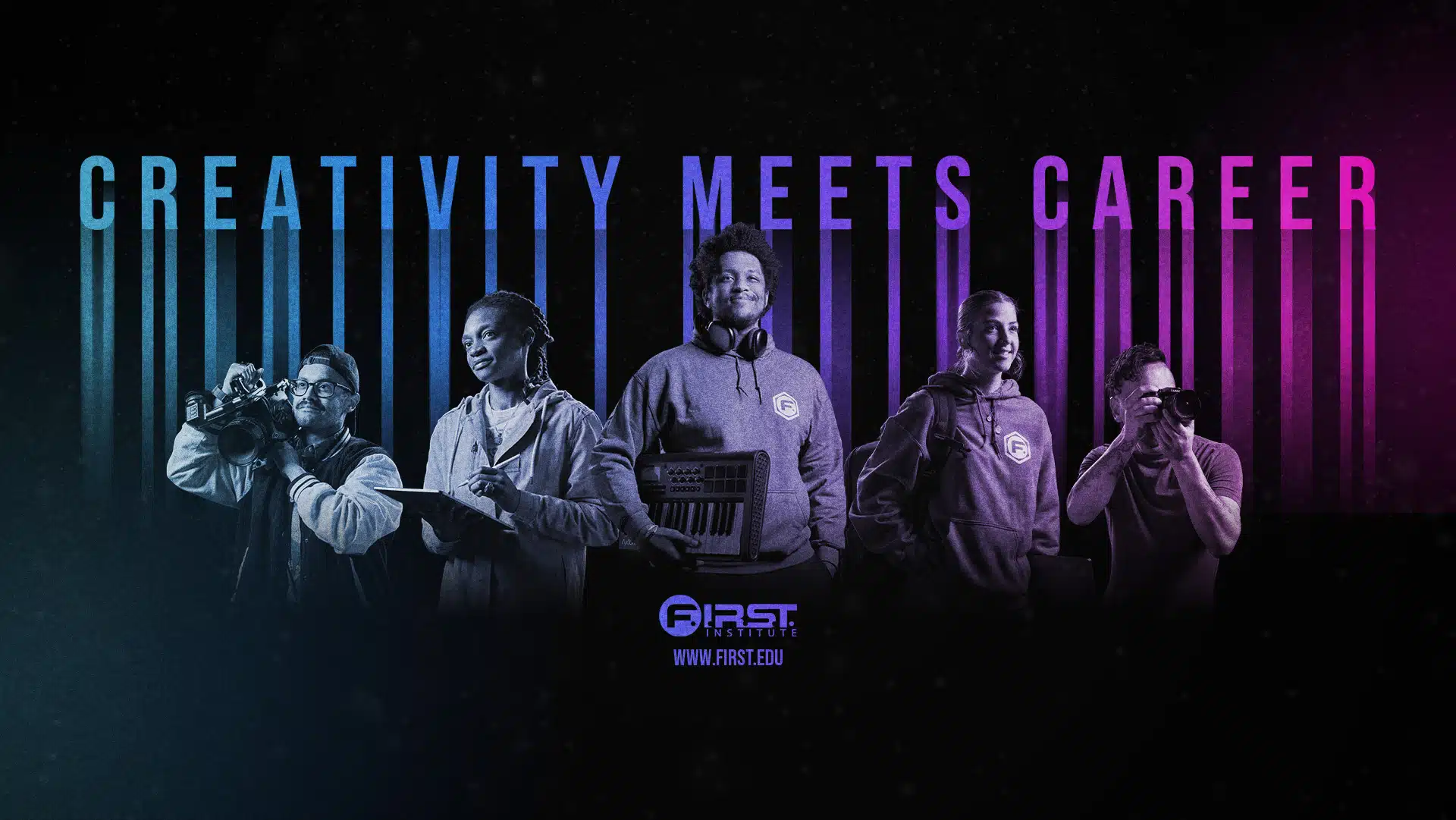CAREER PATHS
DIGITAL FILMMAKING
& VIDEO PRODUCTION
WHERE DO YOU GO NEXT?
There are countless ways to succeed in film & video production today. While some students may already know what they want to pursue, maybe you are just beginning to explore your options.
Discover the various career paths in the film and video industry that our graduates have embarked on. For more insights on how F.I.R.S.T. Institute can assist you in achieving these aspirations, don’t hesitate to ask for further information. Our admissions team is ready to guide you towards a program that perfectly matches your objectives.
- Assistant Camera Operator
- Assistant Director
- Assistant Editor
- Boom Operator
- Broadcast Engineer
- Camera Operator
- Casting Director
- Cinematographer
- Content Creator
- Director
- Editor
- Freelance Videographer
- GAFFER
- Grip
- LOCATION MANAGER
- Production Assistant
- Screen Reader
- Screenwriter
- SPECIAL EFFECTS COORDINATOR
- Video Technician
Assistant camera operators care for many practical elements in rendering the director’s vision with technical precision. While camera operators monitor the set, lighting, rigs, and camera settings, assistants prepare, set up, and position the equipment. Camera assistants fulfill various roles: the 1st assistant camera or “focus puller” adjusts the camera focus as actors and objects move through a scene. 1 ACs also change lenses and filters according to the camera operator and DP’s directions. The 2nd assistant loads film as needed, claps the slate at the beginning of a take, and keeps notes on the equipment for the camera department. Sometimes, these jobs are combined, depending on the size of the shoot. No matter your title, maintenance of the equipment and carefully packing it away at the end of the day will most likely be your responsibility! This is a challenging and often exciting position in a film crew and a great way to start: most camera operators and cinematographers started as camera assistants.
An Assistant Director (AD) plays a crucial role in film and television productions, supporting the director and ensuring the production runs smoothly. They are responsible for organizing the cast and crew, creating the daily shooting schedule, and coordinating with various departments to ensure everything is on track. ADs also assist in rehearsals, manage extras, and ensure the set is safe and compliant with regulations. They are essential in maintaining the director’s vision while keeping the production on schedule and within budget.
An assistant editor is the editor’s right hand throughout the editing process, keeping the editor apprised of everything that’s going on with the production. Assistant editors do everything except cut the film itself, preparing footage for the editor to work on each day, checking for continuity and synchronization within the film, and maintaining a balanced and structured environment in the editing room. This job is a mix of administrative, practical, and creative duties in the name of supporting the editor and the story being created. The assistant editor also receives and interprets paperwork and communications from staff and crew so that the editor can focus on the job at hand, and keeps notes on all aspects of the editing process so that there are records of footage cut, dubbing and effects added, etc. Sometimes assistant editors are given the responsibility of making rough cuts, and even making creative decisions for the editor to speed the process along. Assistants may be asked to arrange workspace, fix technical issues, or organize extra footage: anything that keeps the editor on-schedule! Assistant editors are team-players with great organizational skills and a keen creative eye.
The boom operator’s primary concern is the performers’ dialogue during a shoot. They assist the production sound mixer by operating a boom microphone or placing radio and clip microphones in the correct spots around the set (and even on the performers’ clothing). Boom ops are usually responsible for the upkeep of sound equipment on set, ensuring it is in good working order and carrying out minor repairs as needed. Generally, the job requires strength, agility, patience, and good communication skills. Boom ops can also act as the spokesperson for the sound department with the cast and crew, as production sound mixers often need to work elsewhere. The best boom ops understand lighting and framing, which helps them successfully place or hold the microphone out of the shot. When operating the boom mic itself, operators get to look over the scene’s dialogue beforehand to anticipate how to move the microphone: it’s a skill that takes time to develop but is highly prized by experienced directors!
A Broadcast Engineer is responsible for the technical aspects of broadcasting audio and video signals. They ensure that equipment and systems used for broadcasting, such as cameras, microphones, and transmission equipment, are in good working condition. Broadcast Engineers also troubleshoot and resolve any technical issues during live broadcasts. They are crucial in ensuring that broadcasts are high quality and free from technical glitches.
A Camera Operator is responsible for capturing high-quality video footage for films, TV shows, or other productions. They work closely with directors and cinematographers to bring the director’s vision to life. Camera Operators must have a keen eye for detail, a good sense of composition, and work well under pressure. It’s a creative and technical role that requires skill and dedication.
A Casting Director is responsible for selecting actors for roles in film, television, theater, or other productions. They work closely with directors, producers, and other casting professionals to understand the requirements of each role and then search for actors who fit those requirements. Casting Directors may organize auditions, review actor submissions, and negotiate contracts with selected actors. They need to have a keen eye for talent, excellent communication skills, and the ability to work well under pressure to meet deadlines and fulfill the needs of the production.
A Cinematographer, also known as a Director of Photography (DP), is responsible for the visual aspects of a film or video production. They work closely with the director to achieve the desired look and feel of the project. Cinematographers oversee the camera and lighting crews, choose the right equipment for each shot, and make artistic decisions about framing, lighting, and camera movement. Their goal is to visually tell the story compellingly and engagingly, using their technical expertise and creative vision to create stunning visuals that enhance the overall film or video.
A Content Creator is a critical player in the creative process of developing digital media. They generate ideas, produce content, and often manage the distribution of that content across various platforms. This role involves creativity, strategic thinking, and technical skills to create engaging and compelling content that resonates with the audience. Content Creators work closely with the marketing team to ensure that the content aligns with the overall brand message and goals.
Directors work closely with the film’s producers, cinematographers, and other crew members to bring the script to life. They are responsible for guiding the actors’ performances, making decisions about camera angles and shots, and overseeing the editing process to ensure that the final product meets their artistic vision. Directors must have a strong creative vision, excellent communication skills, and the ability to collaborate with a wide range of people to bring their vision to the screen.
An editor takes all the footage captured by the production crew and pieces it together to create a cohesive and engaging story. Editors work closely with directors to bring their vision to life, selecting the best shots, adding effects, and ensuring the final product meets the creative goals. It’s a role that requires creativity, attention to detail, and a strong understanding of storytelling techniques.
Freelance videographers film and edit anything and everything: documentaries, commercials, online content, even weddings and plays. When working solo, videographers are typically responsible for all aspects of a shoot – recording, possible lighting and audio setups, and editing. They work closely with their clients to achieve the desired results during the filming process and are often trusted to use their own creative eyes during the editing process. Once freelancers establish themselves, they can enjoy complete autonomy in terms of what projects they take on, keeping in mind that generating clientele is vital for those who are starting out. Freelance videographers must be self-motivated when marketing their services and maintain a courteous and professional attitude to ensure return business and positive referrals as they build “their brand.” Freelancing can be highly rewarding, personally and financially, and can help fund artists as they make their projects.
A gaffer maintains everything related to lighting. Working closely with the lighting director, gaffers brainstorm lighting ideas that fit the production’s overall vision. They are directly in charge of electrical safety, the lighting crew, and executing the lighting plan. The gaffer is an essential part of the production crew, as they can ultimately influence a scene with the choice of lighting. An understanding of filmmaking and technical knowledge is necessary to become a gaffer.
The Grips are integral technicians on a film set, building and maintaining all equipment that supports cameras, from tripods, dollies, and tracks to jibs, cranes, and static rigs. Grips help scout for locations and analyze the needs of a project. Depending upon their findings, they will hire or create the equipment necessary to complete complex shots and camera movements. Grips must provide ways of securing the cameras so that everything is safe and sturdy and the shot can be achieved smoothly and successfully. There are different roles for Grips: the Key Grip supervises all grip crews and equipment, the Best Boy oversees administrative duties and keeps an eye on workplace safety standards and procedures, and the Dolly Grip operates the camera dolly, physically pushing and pulling camera rigs in concert with the camera operators. Grips are among the first to arrive at a shoot to set up the camera supports and plan the order in which equipment must be put up and taken down during the day. Grip work is excellent for those with patience, dedication, and strong observation skills and can provide highly satisfying and steady employment.
Location managers are in charge of making arrangements to secure locations for filming. They are tasked with obtaining any permits and scouting for appropriate settings. This position usually oversees location scouts and assistant managers during the process. An essential aspect of this role is public relations. The location manager is the main point of contact for all the locations used during the shoot. They also manage the logistics, including contracts, parking, and travel. During and after the shoot, location managers maintain the site and keep track of time constraints.
The PA is the glue that holds a production together in many ways. PAs assist wherever needed on a production, so duties often range across departments. Taking a gig as a PA is a great way to gain experience with a full array of production personnel, from the camera operators to the costume department. It is an excellent role for breaking into the film industry. PAs are in charge of the production details, which can mean ensuring everyone gets lunch or tidying the set after a shoot, depending on where you are assigned. For example, a set PA typically maintains order on the set: relaying messages, distributing paperwork, and ensuring actors and extras are precisely where they should be. On the other hand, an office PA takes care of administrative duties related to production: answering phones, making reservations, and assisting with information management and data entry. Working as a PA is perfect for organized, friendly individuals who are enthusiastic and willing to take on various daily tasks.
A Script Reader, also known as a Script Analyst, evaluates scripts submitted for consideration by a studio. They carefully read each script and provide detailed feedback on its strengths, weaknesses, and potential. Script Readers must thoroughly understand storytelling principles, screenplay formatting, and industry standards. They also need strong analytical skills to assess the script’s plot, character development, dialogue, and marketability. The feedback provided by Script Readers helps production companies make informed decisions about which scripts to develop or produce.
Screenwriters map out a story, scene, or sequence before production begins. They develop and write scripts that set up scenarios for commercials, films, television, radio, and stage performances. Screenwriters are involved in all phases of pre-production, from idea generation and story development through to script production and rewriting as necessary. Early versions of a script will describe scenarios in detail, including physical environments and moods of characters, and final, shooting scripts will include lighting, camera, and shot instructions for the crew. Screenwriters are creative and dedicated, working with directors and performers to hone the images, actions, and dialog included in a script. Some professional screenwriters work simply on re-tooling other people’s scripts! Screenwriting is a competitive business, but it is also a wonderfully rewarding one.
All special effects done on set are run by the special effects coordinator. This role requires a highly creative individual with a background in film, animation, or computer science. Special effects coordinators oversee the manufacturing of special effects during pre-production and its application on set. They are responsible for the safety protocols that may arise for specific effects. Setting up and operating the rigs is another duty for this position. Most special effects coordinators start as assistants with hands-on experience in the film industry.
Video technicians are crucial when looking at live production instead of digital filmmaking. They are on-site during live entertainment or theater performances, maintaining and operating video production equipment under the supervision of a technical director. The equipment may include video cameras, screens, projectors, media servers, and the grip kit.




